Teaching Resources
Here is this month's site for useful resources:  Curious? See more about Rumbleblocks in the article on the right! RumbleBlocksThis site contains the download for RumbleBlocks, a game that helps 4-11-year-olds learn about stable structures by building towers for an alien.
If you would like us to feature an excellent web source, please let us know.
NAESP offers a new process for school improvement
The steps to school improvement are now eased by using the successful improvement initiative that has been employed by CEI, NAESP's new partner.
.
CEI and NAESP work with more than 1400 trained and certified mentors and school improvement experts, so we have a pool of experts available to respond to a school's needs.
Read more here.
Professional Development
Services
CEI sponsors dozens of training modules on a wide range of categories: Common Core, Intervention Methods, Leadership, Learning Strategies, Planning for Improvement, School Culture, Tools for Teaching.
Sessions range from one hour to two days, and several of them can be arranged for remote delivery.
Go here and select a category.
|
We hope you are enjoying our New! Website
www.edimprovement.org
View our blog, and see bios for our team, feeds from relevant sites, announcements of upcoming events, and descriptions of our services. Thanks to
Monica Jerbi, our Web Content Specialist.
CEI remains committed to providing high-quality research based services, to questioning current strategies, and contemplating the future of education, nationally and globally.
|
|
For more information on our services and modules contact Honor Fede (hfede@naesp.org)
To help us meet your needs, please send an email with answers to the following questions:
1. Primary concern or need: 2. Proposed dates of service:
3. # of teachers:____
4. What you expect from CEI:
|
|
Editor:
Carolyn Lieberg, M.A. |
|
Contact Information
To be removed from this email list please send an email with the header
|
|
|
Dear Educator,
With the push for high academic standards, many administrators are finding they must be constantly ready for the "next" request or requirement from the state or district. With this push for compliance, for continual improvement, it is sometimes most challenging to find time to pause, put the day-to-day management "on hold," so to speak--even if for a few hours--and contemplate something new, innovative, or exciting.
This issue of Wow!Ed has four articles that describe innovations worth a push of that HOLD button--particularly if you are at a time and space where you may be ready to partner with others for the common good. Two of the articles describe programs and opportunities that are being led by Carnegie Mellon University and a joint program they are operating with the University of Pittsburgh, LearnLab.
If you have spent a few hours watching young children with Angry Birds or even if have watched them manipulate YouTube videos, you may have some sense of the future of education. Can you imagine academics without boredom? Students who are self-motivated to learn? Students who, in some cases, are learning at faster and higher rates through games?
If you are ready for innovation--to prepare for the future, you may want to link up with LearnLab and become a research site.
The other two articles provide related information on programs in Minnesota (Kinderprep) and in Pennsylvania (LEAP--a personalized learning program for children with autism spectrum disorders). Both of these preschool programs lay a very solid foundation for future learning.
We invite you to push the HOLD button, sit back, and consider the implications of these exemplary programs for your school.
______________________________________________________
|
| Students in K-3 Learn Physics with New Educational Game | |
By Vincent Aleven, Associate Professor of Human-Computer Interaction, Carnegie Mellon University
Educational games are an important new development in education. Many teachers have heard from their students that they should bring games into the classroom. Many teachers have actually done so, much to the delight of their students. But with so many games to choose from, how can teachers know that the games they bring into their classrooms will actually help their students learn?
Developing educational games that demonstrably help students learn is quite difficult. To crack that nut, researchers at Carnegie Mellon University in Pittsburgh, PA, started a unique collaboration. This university houses leading experts in innovative educational technologies and some really outstanding game designers. Together, they created RumbleBlocks. Designed for students in Kindergarten through grade 3, this game targets basic principles of stability consistent with the framework for physics learning by the National Research Council (NRC). In RumbleBlocks, the player helps an alien who is stranded on earth. As part of that mission, students construct towers that must survive an earthquake. They also make judgments about what makes towers stable. In a future version of the game, they will explain their judgments in terms of basic principles of stability.
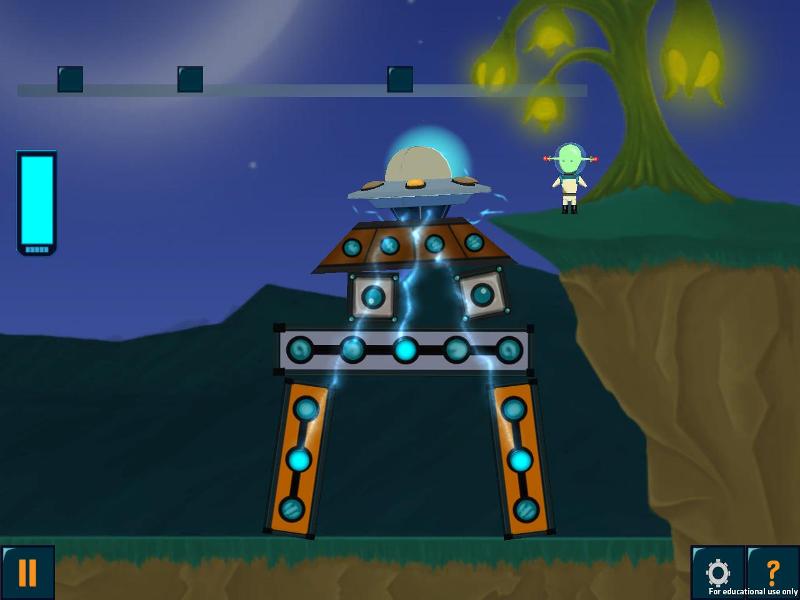
The game was tried at Trafford Elementary School and Level Green Elementary School, both in the Penn-Trafford School District near Pittsburgh. One student commented: "This is like the best game I played in a long time." The teachers participating in the pilot study were happy as well. One said: "I like how the game really makes the students think." Karen Garner, Principal of Trafford Elementary, was equally positive: "Our students were able to participate in a powerful learning experience."
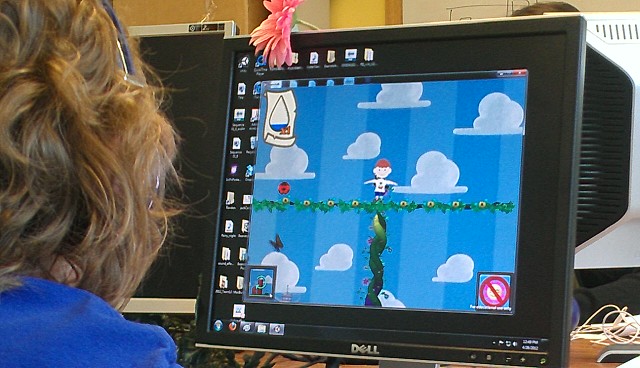 
However, the researchers were not content just collecting feedback from teachers and students. They also tested students to find out if game play boosted their physics understanding outside of the game. They found that indeed it does. In particular, they found the game was effective when it includes levels where the student's task is to compare two towers to identify which one is more stable. This kind of research-based evidence can help teachers who need to decide what to do in their classes. Physics learning can be fun, even for the youngest students!
The Carnegie Mellon researchers are currently developing a suite of games that can be accessed freely. The researchers hope that many students and teachers will play the games, because the game play data will help them improve the games, so that they become a reliable tool that teachers can use when their students ask for games. |
Call for Participation in Learning Research
By Gail Kusbit, LearnLab Research Manager at Carnegie Mellon University
Co-located at Carnegie Mellon University and the University of Pittsburgh, LearnLab is a large non-profit learning research center funded by the National Science Foundation (NSF) with the directive to research and promote progress in learning. LearnLab researchers conduct high-quality math, science, and language learning studies in actual elementary, middle, and high school , and undergraduate college classrooms. LearnLab studies are conducted through free software developed specifically to target difficult topics in a particular domain. There is no cost to schools who participate with us in studies.
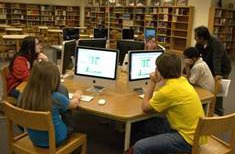
LearnLab's goal is to establish both theoretical and empirical bases for achieving robust learning across varied domains. At the elementary and middle school levels, we regularly conduct studies in:
- Math (fractions, decimals, basic statistics, pre-algebra, algebra)
- Cognitive Tutor® math (Bridge to Algebra, Algebra)
- Elementary and middle school science (teaching experimental design)
Currently LearnLab researchers are seeking participation from interested schools in the 2012-13 academic year for these specific projects:
- Grades K-3: creating effective games for science learning (new project)
- Grades 4-5: supporting fractions learning with an intelligent tutoring system (extensive tutor with many fraction topics-ongoing project)
- Middle School: comprehensively supporting middle school math skills through use of an intelligent tutoring system (extensive tutor with broad range of topics-ongoing project)
Though LearnLab is located in Pittsburgh, Pennsylvania, they collaborate with schools around the country, and we are always looking for new schools interested in joining us in our research.
For more information: If you would like to find out more about collaborating with us at LearnLab, please contact Gail Kusbit, LearnLab Research Manager at Carnegie Mellon University.
gkusbit@cs.cmu.edu
(412) 268-5595
For More Information: Visit @ www.learnlab.org
PRINCIPALS, PLEASE NOTE!
NAESP is collaborating with LearnLab in advancing 21st Century Learning. We have volunteered to help LearnLab find sites for their research. If you develop a collaboration with LearnLab and become one of their sites, please let us know as we would like to track your involvement with them and would welcome the opportunity to help you share your experience and findings with others.
|
 |
Overcoming Economic Barriers with Early Learning
| |
By Jaclyn Swords
Driving more resources toward early education has proven to be a worthy investment. However, what are the most effective methods, particularly with varying socio-economic families and cultures?
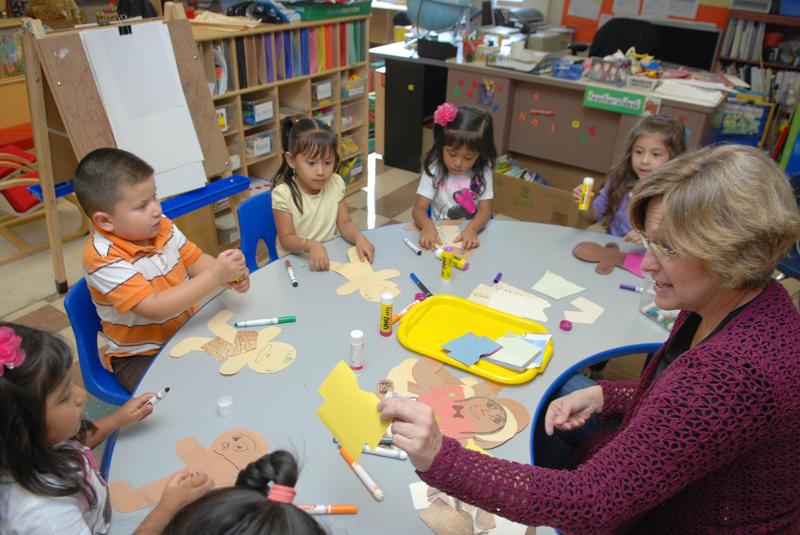
In Minnesota, for Bloomington and Richfield school district's earliest learners, it's Kinderprep -- a preschool for four-year-olds from low-income households and English Learners. Kinderprep -- modeled after a very successful preschool program initially funded by an Early Reading First grant in 2004 -- currently serves 216 students speaking 27 different languages in five locations across these neighboring Minnesota communities.
Kinderprep's primary goal is to close the achievement gap by preparing children who typically perform academically lower than their peers due to economic and language barriers, to score at least as high as the average student on kindergarten assessments. Nearly all of the Kinderprep students who have been in the program for one full year were competitive with other kindergarten students, and remained so through that year in school.
Jon Millerhagen is the principal of Bloomington's Washburn Elementary School, one of two sites in the district that houses a Kinderprep classroom. He is also Minnesota's 2012 National Distinguished Principal. In a Capitol Hill briefing in Washington, D.C. last fall, Millerhagen shared how Bloomington Public Schools is integrating early childhood education in its K-3 system.
The elements Millerhagen shared and endorsed by the Minnesota Elementary School Principals Association are included in the book Making a Difference: 10 Essential Steps to Building a PreK-3 System, by authors Linda Sullivan-Dudzic and Donna Gearns. The steps are:
- Establish need and common interests.
- Locate and connect with early childhood learning environments.
- Develop a leadership group.
- Build high-quality professional development.
- Connect and align quality PreK to Kindergarten.
- Maximize the benefits of full-day Kindergarten.
- Align and connect a strong full-day with grades 1-3.
- Conquer the fade-out.
- Create a sustainable system of support.
- Review, revise and extend.
Identifying goals to track student learning
Bloomington Public Schools believes all children can learn, given appropriate time and support. This belief is what motivates the suburban Twin Cities school system to create innovative learning opportunities for children from birth to graduation, integrating research-based practices in a comprehensive educational approach known as the Pathways to Graduation.
Pathways to Graduation identifies key milestones students need to meet in order to be prepared for the next level of study, graduate on time, and enter college or a career with the necessary skills to be successful. It provides a personalized learning path by aligning the core educational departments - Academic Services, Student Services and Community Services - and linking schools, support departments, programs and strategies into a single, cohesive framework.
Milestones define behaviors, achievement levels, standards, and experiences a child needs to accomplish at certain stages along a personalized pathway to graduation. The six critical milestones include:
Birth to Age 3 Pre-School Ready
Early Childhood (Ages 3-5) Ready for Kindergarten
Grades K-3 Reading by Third Grade
Grades 4-5 Middle School Ready
Grades 6-8 High School Ready
Grades 9-12 College and Career Ready
Indicators identify data collected to monitor progress that the district is making towards preparing students to graduate, and it identifies academic data on individual students to drive classroom instruction and intervention where needed.
The image below is a graphic representation of the Pathways to Graduation framework.
Image below can be located at full size here: 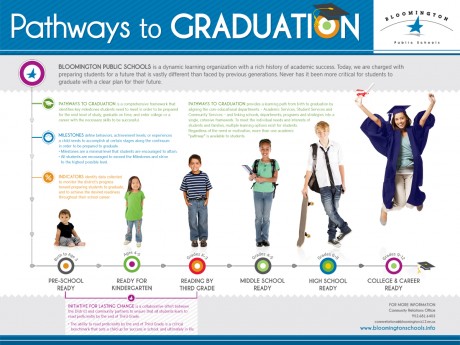
NOTE: Bloomington Public Schools is a large suburban school district southwest of the Twin Cities, serving over 10,300 students in 10 elementary, three middle and two high schools. The district also includes two early learning centers for children under five years old and two alternative learning centers for adult learning experiences.
|
 |
A Personalized School and Home Program for Preschoolers with Autism Spectrum Disorders: Principals Facilitating Hope through LEAP | |
By Suzan Mullane
Principals who champion the needs of children with autism have lots of challenges. Perhaps one of the most important tasks is to instill a sense of personally conveyed hope in teachers and parents who are on the frontline of teaching and care giving. Preschoolers with autism, for instance, require a lot of redirection and physical energy. Hope for improvement, positively communicated and supported by school leaders, creates a wellspring of synergy--a reservoir of shared spoken beliefs that significant gains for students with autism spectrum disorders are doable and that early intervention facilitates the largest impact. Research conclusively supports early intervention (a CDC report and in Scientific American) and a personalized united working relationship between school and home is critical. But what programs are supported by evidence-based research?
Endorsed by US Department of Education's What Works Clearinghouse, a team of reviewers sponsored by the Institute of Educational Sciences, LEAP (2012) is an autism preschool program worthy of a second look. LEAP, developed by Phillip Strain, stands for Learning Experiences--An Alternative Program for Preschoolers and Parents.
The LEAP curriculum seeks to: develop social and emotional growth, enhance language and communication abilities, increase independence in work and play activities, facilitate choice making, increase capacity to cope with transitions and improve behavior, while improving overall cognition and physical abilities. (Simpson, 2005).
The LEAP curriculum includes 15 hours a week of classroom instruction provided by a teacher and assistant to a group of about 13-14 children, 3-4 who have autism. The approach relies heavily on an inclusion and peer-mediated teaching. In some instances the program has been so successful that youth by age 10 no longer met the characteristics of autism on the Childhood Autism Rating Scale (Strain and Hoyson, 2000).
New research supports that the effectiveness of LEAP is significantly enhanced with training, a training that exceeds past methods where teachers only received materials and video guides without expert support. In fact, the difference in professionally supported in-service training complete with student skill maintenance checks showed statistically significant gains on:
- Communication: Mullen Scale of Early Learning Expressive Language Scale
- Behavior: Childhood Autism Rating Scale (CARS) & Social Skill Rating System (SSRS)
- Intellectual: Mullen Scale of Early Learning
- Social outcomes: Social Skills Rating Scale

Recently published, the two-year study (2 yrs. for each cohort) involved 50 preschools from 16 districts over 7 states, which included a multivariate repeated measure analysis of entire classrooms rather than skill acquisition progress from individual children. In other words, statistically significant gains were achieved across state lines in multiple districts. Funding for LEAP was provided through a grant from the National Center for Special Education Research, awarded to the University of Colorado, Denver-principal investigator: P. Strain.
Key research findings from LEAP:
- "The peer facilitative strategies often produce 'day one' effects, suggesting that the delayed social and communicative abilities of many young children with autism may be attributable, in part, to the socially non-responsive settings in which they are most often educated. "
- "The naturalistic or incidental teaching used in LEAP to influence cognitive outcomes yields approximately two months gain for each month enrolled."
Inclusion for special education students is not a new concept but for preschoolers with high needs, more restrictive settings have been the norm. What makes LEAP uniquely different?
- The parent-training component over time
- Training that involves teachers, so generalization of skills from school to home is more likely.
Principals and teachers will be pleased to know that LEAP behavioral materials are available in Spanish to facilitate bilingual families. Dade County has an informative website that can guide administrators who wish to use ideas for their own personalized program.Check out their flyer here.
As principals and school administrators plan and collaborate regarding the BIG questions on autism, such as the need for early intervention and quality proactive measures to avoid future litigation, it is encouraging that there are research-based answers. LEAP could be a key intervention teaching strategy for families with children on the autism spectrum scale and their school communities. In the long run, LEAP could be a cost-saving prescription, as preschoolers acquire the skills for more inclusive instruction. Ultimately, there might be significantly less need for expensive language development programs and intensive behavioral interventions in later years.
References:
Simpson R.L. et al. (2005). Cognitive interventions and treatments. In: Treatments for Children and Youth. California: Corwin Press, pp. 127 168.
Strain, P.S. & Hoyson, M. (2000). On the need for longitudinal, intensive social skill intervention: LEAP follow-up outcomes for children with autism as a case-in-point. Topics in Early Childhood Special Education, 20, 116-122.
 |
|
|
Personalized Learning
The U.S. Department of Education has recently focused on personalized learning. At their website, they say:
"Transitioning away from seat time, in favor of a structure that creates flexibility, allows students to progress as they demonstrate mastery of academic content, regardless of time, place, or pace of learning....strategies include online and blended learning, dual enrollment and early college high schools, project-based and community-based learning, and credit recovery, among others. This type of learning leads to better student engagement because the content is relevant to each student and tailored to their unique needs. It also leads to better student outcomes because the pace of learning is customized to each student." Check out their website for more examples of personalized learning.
If you are looking for strategies for keeping students engaged, for flexible strategies to better meet the needs of all students, it might be worth visiting with others who are implementing personalized learning. We are looking for more examples to help you understand the options, and, potentially, to help you find one that fits your school and your students. So if you find a gem, let us know!
Sincerely,
Christine Mason
Director, Center for Educational Improvement
|
|
|